Special Ceramics are made of aluminum oxide, magnesium oxide and other compounds, which are crushed, shaped, and fired at high temperature by traditional or special methods. Some of them need to be machined or polarized after firing to meet the precision requirements for size and shape, or to make the product have specific ferroelectric properties. Special ceramics can be roughly divided into two categories: structural ceramics and functional ceramics. Structural ceramics far exceed traditional ceramics in terms of strength, hardness, wear resistance, heat resistance, and corrosion resistance. Functional ceramics have special properties such as ferroelectricity, antiferroelectricity, magnetism, gas sensitivity, heat sensitivity, and fast ion conduction.

Magnesium oxide and calcium oxide are indispensable raw materials for pottery, so mixing powders of these two chemical raw materials has become a routine for potters. For ease of understanding, you can think of them as refined flour. Fine flours of different colors still look mottled when they are mixed at first, but as long as they are mixed hard, they will gradually become uniform in color.
Magnesium oxide ceramics are ceramics with magnesium oxide as the main component. Belongs to cubic crystal system, NaCl type structure. The melting point of magnesium oxide is 2800°C±13°C. Its Mohs hardness is 6, its tensile strength, compressive strength and bending strength are much lower than that of sintered Al2O3, and its high temperature strength is also lower. Magnesium oxide is a good insulator, the resistivity at room temperature is >1014Ω·cm, and the resistivity decreases sharply as the temperature rises.
Magnesium oxide ceramics is a typical basic refractory material, which can work stably up to 2400°C in an oxidizing atmosphere or under the protection of nitrogen; in a reducing atmosphere, magnesium oxide will decompose and volatilize in the form of metal magnesium, and start to volatilize in a large amount at 1600°C in a vacuum ; Fe, Zn, Pb, Cu, M and other metals do not have a reducing effect on it. Magnesium oxide ceramics can be used as crucibles for smelting metals, and are also suitable for smelting high-purity uranium and thorium in the atomic energy industry; they can also be used as thermocouple protection sleeves. Utilizing its property of allowing electromagnetic waves to pass through, it can be used as a transmission window material for radome and infrared radiation.
